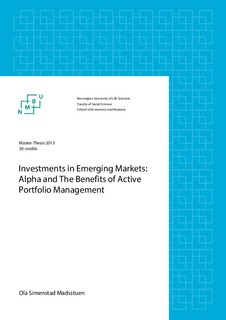| dc.contributor.author | Madsstuen, Ola Simenstad | |
| dc.date.accessioned | 2015-08-06T13:40:20Z | |
| dc.date.available | 2015-08-06T13:40:20Z | |
| dc.date.copyright | 2015 | |
| dc.date.issued | 2015-08-06 | |
| dc.identifier.uri | http://hdl.handle.net/11250/295322 | |
| dc.description.abstract | In this thesis, I investigate whether investments in emerging market stocks can generate a higher risk-adjusted portfolio return than investments in developed markets. To investigate the possibilities of abnormal performances, I use stock indices representing emerging markets in the period of January 2001 to December 2014.
My underlying hypothesis is set in context with active- and passive portfolio allocation. By backtesting my assumed active portfolio strategies, I can obtain adequate number of test results to answer my underlying hypothesis. The active emerging market portfolio strategies are the Maximum Sharpe portfolio and the Minimum Variance portfolio. In order to see the risk-return effects, I chose the MSCI World index as benchmark index. Moreover, I use the information rate as a measure of active management success.
The success of an active portfolio strategy hinges on the existence of alpha. In order to find evidence of its existence, I dedicate my second analysis to cover asset-pricing models. I base my analysis on the three-factor model of Fama and French (1993). I experiment with my backtested portfolios and a dataset covering style stocks from the BRICS.
I found that the active emerging market portfolios did not generate a higher risk-adjusted return than the benchmark index. On an unadjusted basis, the Minimum Variance portfolio performed best. The multifactor asset-pricing models indicated a size premium on this portfolio that explained some of the performance.
I also found significant size- and value premiums of the BRICS style portfolios. The multifactor asset-pricing models provided evidence of the shortcomings of the CAPM. Specifically, small stocks seem to have return patterns in which the market beta lack the ability to explain.
Based on my findings, I suggest that passive replication strategies can generate just as high returns as active portfolio strategies by reaping premiums of risky stocks. For future research, I encourage further investigation of the size and value anomalies within emerging market stocks. | nb_NO |
| dc.language.iso | eng | nb_NO |
| dc.publisher | Norwegian University of Life Sciences, Ås | |
| dc.rights | Navngivelse 3.0 Norge | * |
| dc.rights.uri | http://creativecommons.org/licenses/by/3.0/no/ | * |
| dc.subject | alpha | nb_NO |
| dc.subject | asset-pricing models | nb_NO |
| dc.subject | Fama-French | nb_NO |
| dc.subject | Active portfolio management | nb_NO |
| dc.subject | Emerging Markets | nb_NO |
| dc.title | Investments in emerging markets : alpha and the benefits of active portfolio management | nb_NO |
| dc.type | Master thesis | nb_NO |
| dc.subject.nsi | VDP::Social science: 200::Economics: 210::Econometrics: 214 | nb_NO |
| dc.source.pagenumber | 71 | nb_NO |
| dc.description.localcode | M-ØA | nb_NO |

